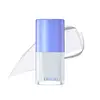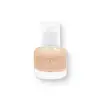What's inside
What's inside
 Key Ingredients
Key Ingredients

 Benefits
Benefits

 Concerns
Concerns

 Ingredients Side-by-side
Ingredients Side-by-side

Water
Skin ConditioningGlycerin
HumectantMethyl Trimethicone
Skin ConditioningOctyldodecyl Stearoyl Stearate
EmollientPentaerythrityl Stearate/Caprate/Caprylate/Adipate
EmollientCI 77891
Cosmetic ColorantHydrogenated Polydecene
EmollientPentylene Glycol
Skin Conditioning1,2-Hexanediol
Skin ConditioningHydrogenated Olive Oil
Skin ConditioningOlea Europaea Fruit Oil
MaskingOlea Europaea Oil Unsaponifiables
Skin ConditioningOpuntia Coccinellifera Fruit Extract
Skin ConditioningSodium Hyaluronate
HumectantChitosan
Hydrolyzed Hyaluronic Acid
HumectantHyaluronic Acid
HumectantPolymethylsilsesquioxane
Trimethylsiloxysilicate
EmollientAmmonium Acryloyldimethyltaurate/Vp Copolymer
Betaine
HumectantBisabolol
MaskingIsododecane
EmollientPotassium Cetyl Phosphate
EmulsifyingHydroxyethyl Acrylate/Sodium Acryloyldimethyl Taurate Copolymer
Emulsion StabilisingSilica
AbrasiveSorbitan Sesquioleate
EmulsifyingPanthenol
Skin ConditioningGlyceryl Caprylate
EmollientC12-20 Alkyl Glucoside
EmulsifyingAluminum Hydroxide
EmollientSodium Acrylate/Sodium Acryloyldimethyl Taurate Copolymer
Emulsion StabilisingPolyisobutene
Triethoxycaprylylsilane
Adenosine
Skin ConditioningTrisodium Ethylenediamine Disuccinate
Caprylyl/Capryl Glucoside
CleansingSorbitan Oleate
EmulsifyingBeta-Glucan
Skin ConditioningButylene Glycol
HumectantDipropylene Glycol
HumectantPropanediol
SolventHydrogenated Lecithin
EmulsifyingCholesterol
EmollientBenzyl Glycol
SolventHydrolyzed Glycosaminoglycans
HumectantCeramide NP
Skin ConditioningHydroxypropyltrimonium Hyaluronate
Sodium Hyaluronate Crosspolymer
HumectantEthylhexylglycerin
Skin ConditioningSodium Acetylated Hyaluronate
HumectantHydrolyzed Sodium Hyaluronate
Skin ConditioningPotassium Hyaluronate
Skin ConditioningC14-22 Alcohols
Emulsion StabilisingCetearyl Alcohol
EmollientParfum
MaskingAlpha-Isomethyl Ionone
PerfumingLinalool
PerfumingWater, Glycerin, Methyl Trimethicone, Octyldodecyl Stearoyl Stearate, Pentaerythrityl Stearate/Caprate/Caprylate/Adipate, CI 77891, Hydrogenated Polydecene, Pentylene Glycol, 1,2-Hexanediol, Hydrogenated Olive Oil, Olea Europaea Fruit Oil, Olea Europaea Oil Unsaponifiables, Opuntia Coccinellifera Fruit Extract, Sodium Hyaluronate, Chitosan, Hydrolyzed Hyaluronic Acid, Hyaluronic Acid, Polymethylsilsesquioxane, Trimethylsiloxysilicate, Ammonium Acryloyldimethyltaurate/Vp Copolymer, Betaine, Bisabolol, Isododecane, Potassium Cetyl Phosphate, Hydroxyethyl Acrylate/Sodium Acryloyldimethyl Taurate Copolymer, Silica, Sorbitan Sesquioleate, Panthenol, Glyceryl Caprylate, C12-20 Alkyl Glucoside, Aluminum Hydroxide, Sodium Acrylate/Sodium Acryloyldimethyl Taurate Copolymer, Polyisobutene, Triethoxycaprylylsilane, Adenosine, Trisodium Ethylenediamine Disuccinate, Caprylyl/Capryl Glucoside, Sorbitan Oleate, Beta-Glucan, Butylene Glycol, Dipropylene Glycol, Propanediol, Hydrogenated Lecithin, Cholesterol, Benzyl Glycol, Hydrolyzed Glycosaminoglycans, Ceramide NP, Hydroxypropyltrimonium Hyaluronate, Sodium Hyaluronate Crosspolymer, Ethylhexylglycerin, Sodium Acetylated Hyaluronate, Hydrolyzed Sodium Hyaluronate, Potassium Hyaluronate, C14-22 Alcohols, Cetearyl Alcohol, Parfum, Alpha-Isomethyl Ionone, Linalool
Water
Skin ConditioningCyclopentasiloxane
EmollientTitanium Dioxide
Cosmetic ColorantGlycerin
HumectantHydrogenated Polydecene
EmollientDimethicone
EmollientDipropylene Glycol
HumectantPhenyl Trimethicone
Skin ConditioningPEG-10 Dimethicone
Skin ConditioningDisteardimonium Hectorite
StabilisingMagnesium Sulfate
Cetyl PEG/PPG-10/1 Dimethicone
EmulsifyingPentylene Glycol
Skin ConditioningCamellia Sinensis Leaf Water
MaskingMethyl Methacrylate Crosspolymer
Dimethicone/Vinyl Dimethicone Crosspolymer
Skin ConditioningAcrylates/Dimethicone Copolymer
Skin Conditioning1,2-Hexanediol
Skin ConditioningPalmitic Acid
EmollientAluminum Hydroxide
EmollientGlyceryl Caprylate
EmollientCaprylyl Glycol
EmollientTriethoxycaprylylsilane
Synthetic Fluorphlogopite
Ethylhexylglycerin
Skin ConditioningMyristic Acid
CleansingStearic Acid
CleansingTocopherol
AntioxidantCI 77492
Cosmetic ColorantCI 77491
Cosmetic ColorantCI 77499
Cosmetic ColorantWater, Cyclopentasiloxane, Titanium Dioxide, Glycerin, Hydrogenated Polydecene, Dimethicone, Dipropylene Glycol, Phenyl Trimethicone, PEG-10 Dimethicone, Disteardimonium Hectorite, Magnesium Sulfate, Cetyl PEG/PPG-10/1 Dimethicone, Pentylene Glycol, Camellia Sinensis Leaf Water, Methyl Methacrylate Crosspolymer, Dimethicone/Vinyl Dimethicone Crosspolymer, Acrylates/Dimethicone Copolymer, 1,2-Hexanediol, Palmitic Acid, Aluminum Hydroxide, Glyceryl Caprylate, Caprylyl Glycol, Triethoxycaprylylsilane, Synthetic Fluorphlogopite, Ethylhexylglycerin, Myristic Acid, Stearic Acid, Tocopherol, CI 77492, CI 77491, CI 77499
 Reviews
Reviews

Ingredients Explained
These ingredients are found in both products.
Ingredients higher up in an ingredient list are typically present in a larger amount.
1,2-Hexanediol is a synthetic liquid and another multi-functional powerhouse.
It is a:
- Humectant, drawing moisture into the skin
- Emollient, helping to soften skin
- Solvent, dispersing and stabilizing formulas
- Preservative booster, enhancing the antimicrobial activity of other preservatives
Aluminum Hydroxide is a form of aluminum. It can be naturally found in nature as the mineral gibbsite. In cosmetics, Aluminum Hydroxide is used as a colorant, pH adjuster, and absorbent.
As a colorant, Aluminum Hydroxide may add opacity, or reduce the transparency. Aluminum hydroxide is contains both basic and acidic properties.
According to manufacturers, this ingredient is an emollient and humectant. This means it helps hydrate the skin.
In medicine, this ingredient is used to help relieve heartburn and help heal ulcers.
There is currently no credible scientific evidence linking aluminum hydroxide in cosmetics to increased cancer risk.
Major health organizations allow the use of aluminum hydroxide in personal care products and have not flagged it as a carcinogenic risk at typical usage levels.
Learn more about Aluminum HydroxideDipropylene Glycol is a synthetically created humectant, stabilizer, and solvent.
This ingredient helps:
Dipropylene glycol is technically an alcohol, but it belongs to the glycol family (often considered part of the ‘good’ alcohols). This means it is hydrating and gentle on skin unlike drying solvent alcohols like denatured alcohol.
As a masking agent, Dipropylene Glycol can be used to cover the smell of other ingredients. However, it does not have a scent.
Studies show Dipropylene Glycol is considered safe to use in skincare.
Learn more about Dipropylene GlycolEthylhexylglycerin (we can't pronounce this either) is commonly used as a preservative and skin softener. It is derived from glyceryl.
You might see Ethylhexylglycerin often paired with other preservatives such as phenoxyethanol. Ethylhexylglycerin has been found to increase the effectiveness of these other preservatives.
Glycerin is already naturally found in your skin. It helps moisturize and protect your skin.
A study from 2016 found glycerin to be more effective as a humectant than AHAs and hyaluronic acid.
As a humectant, it helps the skin stay hydrated by pulling moisture to your skin. The low molecular weight of glycerin allows it to pull moisture into the deeper layers of your skin.
Hydrated skin improves your skin barrier; Your skin barrier helps protect against irritants and bacteria.
Glycerin has also been found to have antimicrobial and antiviral properties. Due to these properties, glycerin is often used in wound and burn treatments.
In cosmetics, glycerin is usually derived from plants such as soybean or palm. However, it can also be sourced from animals, such as tallow or animal fat.
This ingredient is organic, colorless, odorless, and non-toxic.
Glycerin is the name for this ingredient in American English. British English uses Glycerol/Glycerine.
Learn more about GlycerinGlyceryl Caprylate comes from glycerin and caprylic acid, a fatty acid from coconut. It has emollient and emulsifier properties.
As an emollient, it helps hydrate your skin. Emollients work by creating a barrier on your skin to trap moisture in, helping to keep your skin soft and smooth.
On the other hand, emulsifiers prevent ingredients (such as oil and water) from separating.
Learn more about Glyceryl CaprylateHydrogenated Polydecene is an emollient. It creates a non-occlusive film on the skin that offers extra protection for your skin barrier.
The texture of Hydrogenated Polydecene ranges from light and silky to rich.
Hydrogenated Polydecene is the end compound of controlled hydrogenation of Polydecene.
Learn more about Hydrogenated PolydecenePentylene glycol is typically used within a product to thicken it. It also adds a smooth, soft, and moisturizing feel to the product. It is naturally found in plants such as sugar beets.
The hydrophilic trait of Pentylene Glycol makes it a humectant. As a humectant, Pentylene Glycol helps draw moisture from the air to your skin. This can help keep your skin hydrated.
This property also makes Pentylene Glycol a great texture enhancer. It can also help thicken or stabilize a product.
Pentylene Glycol also acts as a mild preservative and helps to keep a product microbe-free.
Some people may experience mild eye and skin irritation from Pentylene Glycol. We always recommend speaking with a professional about using this ingredient in your routine.
Pentylene Glycol has a low molecular weight and is part of the 1,2-glycol family.
Learn more about Pentylene GlycolTriethoxycaprylylsilane is a silicone used to bind and stabilize ingredients.
As an emulsifier, it helps prevent ingredients from separating. This can help elongate the shelf life of products.
Triethoxycaprylylsilane is often used to coat mineral sunscreens ingredients to help give a better feel. It also helps reduce oxidative stress in sunscreens.
Learn more about TriethoxycaprylylsilaneWater. It's the most common cosmetic ingredient of all. You'll usually see it at the top of ingredient lists, meaning that it makes up the largest part of the product.
So why is it so popular? Water most often acts as a solvent - this means that it helps dissolve other ingredients into the formulation.
You'll also recognize water as that liquid we all need to stay alive. If you see this, drink a glass of water. Stay hydrated!
Learn more about Water